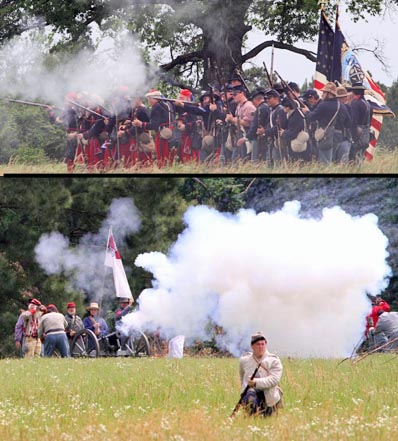| |
# |
Site |
Comments |
Photo |
Visits |
21 |
Chattanooga: Lookout Mt. & Missionary Ridge
Chattanooga National Military Park
Tennessee

|
After the loss at Chickamauga, U.S. Grant was given command of the Union army encamped at Chattanooga and surrounded by Braxton Bragg's Confederate troops on the highlands above. On 24 Nov 1863, the federals assaulted Lookout Mt. in the "Battle above the Clouds" and retook this high point. The next day, across the city, Union troops stormed the base of Missionary Ridge and kept right on going to the top, routing the entire Confederate army in perhaps the most unanticipated breakthrough during the War.
Lookout Mt. is well-preserved today, with stunning views of Chattanooga. This is such a spectacular visual treat that it rates highly, although a better designed battlefield experience would be welcome. Missionary Ridge is not part of the National Military Park. Unfortunately, it is a city park overrun with graffiti and winos, and if that weren't enough, developed private property everywhere precludes any decent views or interpretation. Some headway is being made by the Civil War Trust to acquire some new sites, but at the moment it is a work in progress with a gorgeous centerpiece on Lookout Mt.
|
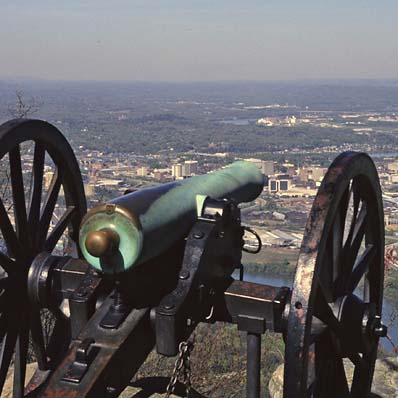 A cannon at the top of Lookout Mountain overlooks
A cannon at the top of Lookout Mountain overlooks
the city of Chattanooga (March 1997) |
June
1967,
Mar
1997 |
22 |
Fredericksburg
National Military Park
Virginia

|
Union Gen. Ambrose Burnside launched his ill-fated attack on the CSA position on Maryes Heights in Dec 1862. He was delayed for 10 days when pontoon boats failed to arrive; during that time Confederate forces doubled to 80,000. At last, on 11 Dec, 106,000 federals crossed the Rappahannock to storm the town and the heights. Lee's troops were well-positioned behind a stone wall and it was a slaughter on 13 Dec. Yankees almost broke through in Jackson's area, but that not supported and fizzled. 12,700 Union were battlefield casualties (~2.5 times rebel losses).
The battlefield is incorporated within the old part of the town of Fredericksburg. The town is in moderately historic condition -- as is historic Chatham Mansion across the river -- and merges reasonably well into the battlefield (unlike the garish modern malls at Franklin). New for me in 2009 was a statute honoring a South Carolina soldier Richard Kirkland who bravely brought water to wounded Union soldiers on the field during the terrible night of 13 Dec. |
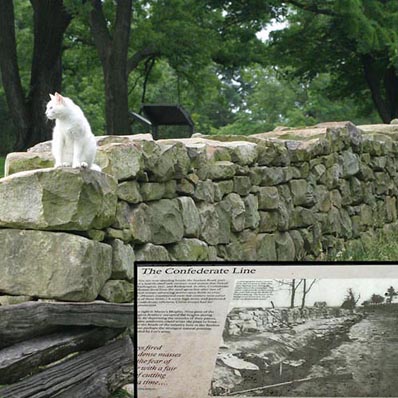 Local cat sits atop remnant of the stone wall on Maryes Heights,
the Confederate position; inset shows historic photo of the site (June 2009)
Local cat sits atop remnant of the stone wall on Maryes Heights,
the Confederate position; inset shows historic photo of the site (June 2009) |
June 1967, June 2009
|
23 |
Chancellorsville
Chancellorsville
National Military Park
Virginia

|
Chancellorsville is Gen. Robert E. Lee's most famous victory. After the devastating Union defeat at Fredericksburg, Gen. "Fighting Joe" Hooker took charge of the Union Army's ~100,000 men. He devised a plan to envelop Lee's army. But on 2 May 1863, Lee sent "Stonewall" Jackson's corps on a 16-mile daylight march through the Wilderness to strike Hooker's exposed flank, splitting his smaller Army to do so. The flank attack was a great success, but Jackson was accidentally shot by his own men in the confusion [Jackson died on 10 May at Guinea Station; see below]. Lee wrapped up his "masterpiece" by 4 May, and Hooker withdrew. This led to Lee's 2d invasion of the North.
The Chancellorsville battlefield is wedged between two great battlefields in Grant's 1864 campaign, and is thus hard to interpret for visitors. It is also mostly dense woods (as it was 1863) but difficult to appreciate, compared to more open locales. Yet Civil War Trust acquisition of land has already significantly aided interpretation of Jackson's flank attack, and a visit now is much better than it used to be. |
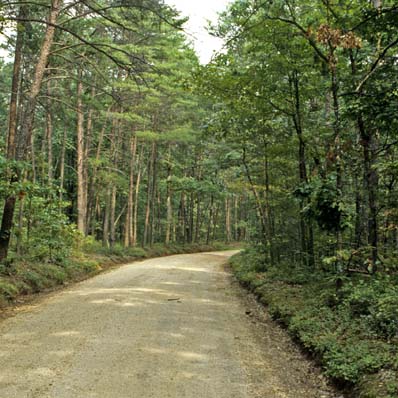
A gravel road follows a portion of "Stonewall" Jackson's flank march on 2 May 1863 (Aug 1997) |
June 1967, Aug 1997, May 2013 |
24 |
The Wilderness
Wilderness National Military Park
Virginia

|
The Battle of the Wilderness over 5-6 May 1864 is one of the great battles of the War, and the first between Gen. U.S. Grant and Gen. R.E. Lee. The tactics of the battle are interesting, and there were compelling stories, including the accidental wounding of CSA Gen. Longstreet by his own men, and the "Lee to the Rear" events when he ventured too close to the front. Over 163,000 men were engaged here (102K federal, 61K rebel) and casualties were heavy (17% federal, 13% rebel). The North lost six generals killed, wounded, or captured; the South lost seven.
The problem from a visitor's perspective is that the Wilderness is, er, dense woods. One cannot view topography from inside the forest. The paved roads with cars zipping through the woods don't help the experience. I admit, however, that things have improved recently. During a 2013 visit there were many more sites to see, trails to walk, and much better interpretive signs. New signs included period photos, or useful maps, or evocative art. A current visit is much more enjoyable than it was in my youth.
|
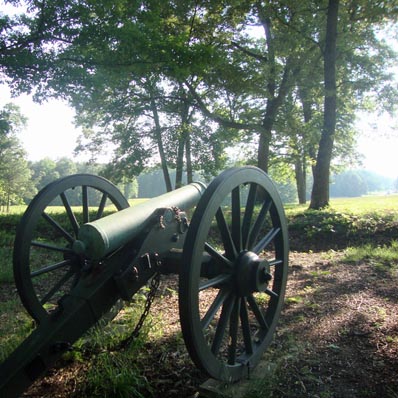 Canon at edge of Saunder's Field, The Wilderness (May 2013) Canon at edge of Saunder's Field, The Wilderness (May 2013)
|
June 1967, Aug 1997, May 2013 |
25 |
Spotsylvania Court House
Spotsylvania Court House National Military Park
Virginia

|
Just south of the Rapidan River in Virginia are three major battlefield sites, each merging into the next. To the north is the Wilderness (5-6 May 1864) and a few miles south is Spotsylvania Court House (9-18 May 1864), which are part of U.S. Grant's conclusive campaign that extends to April 1865. In between the two battlefields is Chancellorsville, fought the preceding year (4 May 1863). Because these locales are intertwined, it is difficult to interpret and a bit difficult to visit these battlefields.
Spotsylvania has more fields and less woods than the Wilderness, so there are markers and monuments to view, especially along a salient following a crooked country lane, known as the "Bloody Angle." Union Gen. John Sedgwick was killed by a sniper at Spotsylvania, and that spot is also commemorated.
|
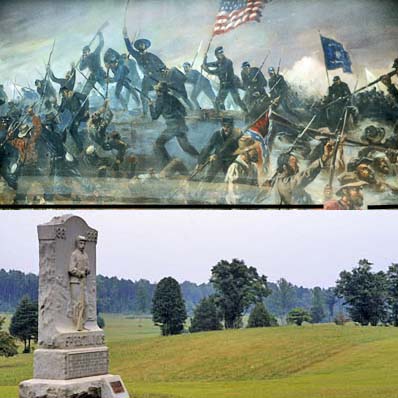 Contemporary painting of fighting at the "Bloody Angle" (top; from a battlefield sign); view of the field near the Bloody Angle with 15th New Jersey monument (bottom; Aug 1997)
Contemporary painting of fighting at the "Bloody Angle" (top; from a battlefield sign); view of the field near the Bloody Angle with 15th New Jersey monument (bottom; Aug 1997) |
June 1967,
Mar
1997 |
26 |
New Market
New Market State Historical Site & Virginia Museum of the Civil War
Virginia

|
This
is a fairly new battlefield site that did not exist during my early
trips back East. It is a jewel of a site in the Shenandoah Valley,
featuring both the New Market battlefield and the adjacent Virginia
Museum of the Civil War. As a battlefield there is not much beyond the
main field of CSA Gen. John C. Breckinridge's attack on the center of
Union Gen. Franz Sigel's troops on 15 May 1864, during the last
desperate southern push to drive the Yankees from the Shenandoah. Only
~10,000 men were engaged (5K per side), but these included 247 cadets
from Virginia Military Academy (inset left). Their story is heavily
featured at the site and in the Museum.
During
our visit in June, a "Living History" on farm life in the Shenandoah
was underway at the historic Bushong Farm at the heart of the
battlefield, adding much to the experience. The two-level museum had
many unique artifacts and fine exhibits, not to mention a good film in
the huge theatre. Although New Market was a small battle, and
unimportant in the "big picture," its interpretation here is
outstanding. |
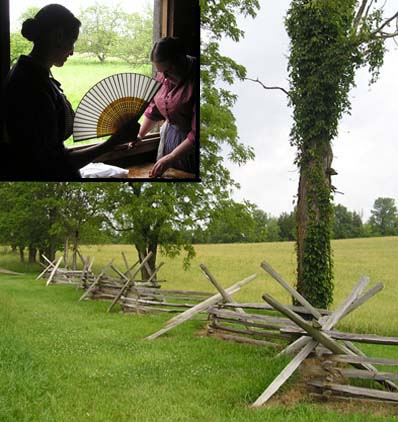 New Market Battlefield near Bushong Farm; living history at the Farm (inset; June 2009)
New Market Battlefield near Bushong Farm; living history at the Farm (inset; June 2009) |
June 2009 |
27 |
Cedar Creek
Cedar Creek & Belle Grove National Historical Park
Virginia

|
While Grant and Lee were stalemated in summer 1864, CSA Gen Jubal Early's army briefly threatened Washington but returned to the Shenandoah. US Gen. Phil Sheridan was sent with a new army to retake that Valley for good. On 19 Oct, while Sheridan was away at Winchester, Early attacked across Cedar Creek and routed the Union left. After a dramatic ride on his horse Rienzi (renamed Winchester thereafter), Sheridan rallied the Union reserves and retook the entire field. This Union victory, combined with the fall of Atlanta, assured Lincoln's second term election.
Cedar Creek and Belle Grove NHP was created in 2001; it is a park-in-development. 3,700 acres are authorized but over half are still privately owned. Our limited time in 2009 precluded a proper visit, but we anticipate improved access and interpretation in future years. [When Sheridan's horse Winchester died, it was taxidermied, and can be seen today at the Smithsonian Museum! Nice horse.].
|
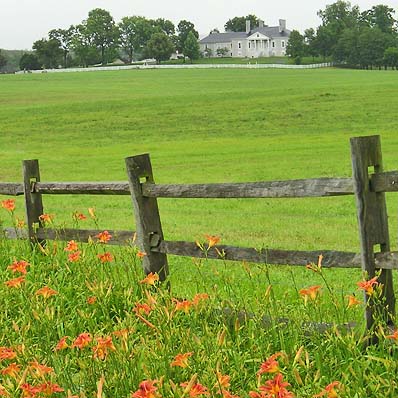 Belle Grove mansion on Cedar Creek battlefield (June 2009)
Belle Grove mansion on Cedar Creek battlefield (June 2009) |
June
2009 |
28 |
Brandy Station
CWPT Brandy Station Battlefield, and Graffiti House
Virginia

|
At the start of his Gettysburg campaign, CSA Gen. Lee ordered Gen. J.E.B. Stuart’s cavalry to stage a diversionary raid on June 9, 1863. That day Union Gen. Alfred Pleasonton’s cavalry crossed the Rappahannock and unexpectedly hit Stuart’s massed horsemen. Northern forces had the upper hand until Stuart’s men arrived on Fleetwood Hill in time to hold that high ground. At one point Union forces might have captured Lee himself — viewing the fight from a nearby home —if they had known he was there. Pleasanton re-crossed the river at 5 p.m., leaving the battle as a “draw,” but this largest cavalry engagement of the War greatly improving the morale of Union cavalry.
This was not a public site until recently. The Civil War Trust has purchased over 1850 acres since 2011. During my visit in May 2013 they had not yet acquired the prime property atop Fleetwood Hill – but now they have. Someday a visitor will be able to explore extensively through walking trails and excellent signage. What makes a visit here unique is the 1854 two-story “Graffiti House” in the small town of Brandy Station. Used as a hospital by both sides, the walls of the second floor contain drawings and signatures of Civil War soldiers that remain vivid today. Be sure to see it.
|
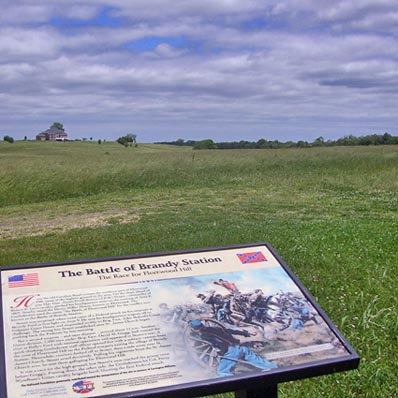 Fleetwood Hill (where house stands in the distance), on the Brandy Station battlefield, was the key to this cavalry battle (May 2013) Fleetwood Hill (where house stands in the distance), on the Brandy Station battlefield, was the key to this cavalry battle (May 2013) |
May
2013 |
29 |
Glorieta Pass
Glorieta State Battlefield
New Mexico |
Only the keenest Civil War buff is likely to know that a battle took place in New Mexico on 26-28 Mar 1862, but it is called "The Gettysburg of the West." Confederate Gen. Henry Sibley led Texas Rangers into New Mexico to capture Ft. Union. They occupied Sante Fe on 23 March. A force headed for Ft. Union, led by Maj. Pyron, were surprised by Union troops & Colorado volunteers, led by Maj. Chivington, at Glorieta Pass. After two days of skirmishing, the major fight took place at the Pass on 28 Mar, while part of Chivington's force circled behind and burned the rebel's supply wagons. This forced a retreat, and tended southern plans to capture the Southwest. In all only 3000 men were engaged (<2% of forces engaged at Gettysburg) but the results were decisive.
My visit was over 40 years ago when there was simply this stone marker and a sign with a map illustrating the flow of battle. I understand that additional land has since been saved and some of it can be visited. I look forward to doing so again. |
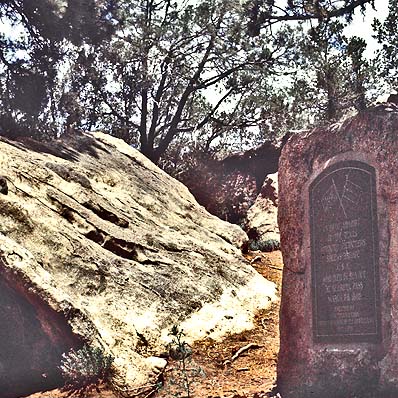 Old stone marker in rocky defile at Glorieta Pass (June 1970)
Old stone marker in rocky defile at Glorieta Pass (June 1970) |
June 1970 |
30 |
Mansfield
Mansfield State Historic Site, and
Pleasant Hill
Louisiana


|
These back-to-battle battles in northwest Louisiana on 8-9 Apr 1864 turned back Union Gen. Nathaniel Banks’ ill-fated Red River Campaign. No one was really in charge of strategy, and things went awry when Banks’ Army left the safety of Naval support about half-way up the Red River, and marched inland. CSA Gen. Richard Taylor had spent a month retreating but attacked Banks’ strung-out forces at Mansfield. The charge pushed the Yankees back for miles but was costly in loss of field officers. What Taylor didn't know was that A.J. Smith’s battle-hardened western troops were in reserve near Pleasant Hill. When he renewed the attack on 9 April, the rebels were crushed by Smith’s “great right wheel,” and driven back to Mansfield. Smith urged Banks to continue the campaign but Banks abandoned the fight and retreated to New Orleans, leaving most of Louisiana in southern hands for the rest of the war. Southerners view Mansfield as a great victory (and ignore Pleasant Hill), but it was the Union command failures that doomed this campaign.
The Mansfield battlefield is preserved and boosts a fine museum. All sites for the Pleasant Hill battle, fought the next day some 17 miles south, are in private ownership. There, one can visit a small cemetery, view roadside memorials, and see the fields across which the battle was fought. The Mansfield museum covers both battles well.
Purely by luck we happened to visit on 27 Apr 2014 – weeks after the true sesquicentennial – and learned that “phase three” of the Battle of Mansfield was to be re-enacted that day! This occurred on a portion of the actual battlefield not usually open to the public, and added immensely to our visit to this nicely-preserved site.
See full page on the Re-enactment |
|
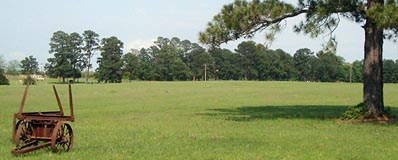 Re-enactment on Mansfield battlefield includes the 165th N.Y. Zouaves (upper) and CSA artillery (middle). Pleasant Hill battlefield is in private hands, viewed from a public road (bottom; all Apr 2014)
Re-enactment on Mansfield battlefield includes the 165th N.Y. Zouaves (upper) and CSA artillery (middle). Pleasant Hill battlefield is in private hands, viewed from a public road (bottom; all Apr 2014) |
|
April 2014 |
|
RECOMMENDED BOOKS & MEDIA :
21. Battle for Chattanooga: Lookout Mountain & Missionary Ridge
- Books: Two excellent books: Wiley Sword's (1994) Mountains Touched with Fire: Chattanooga Besieged, 1863, and Peter Cozzens' (1994) The Shipwreck of their Hopes: the Battles for Chattanooga. Both are well-written; Sword has more photos, Cozzens has better maps. And long ago I was impressed with Missionary Ridge from, among others, Bruce Catton's (1968) Grant Takes Command.
22. Battle of Fredericksburg
- Media: The 2003 movie Gods & Generals, starring Stephen Lang (as Jackson), Robert Duvall (as Lee), and Jeff Daniels (as Chamberlain) includes the Battle of Fredericksburg, where it focuses on Joshua Lawrence Chamberlain. The acting was fine but it is unnerving to see Chamberlain, supposedly in Dec 1862, looking ten years older then he did at Gettysburg in July 1863 (as shown in the film Gettysburg; Gods & Generals is a prequel but was filmed ten years later!). I also preferred Martin Sheen's portrayal of Robert E. Lee (in Gettysburg) over that of Robert Duvall as Lee (in Gods & Generals). Finally, although the budget for Gods & Generals was $65 million, the CG (=computer generated) version of the attacks on Maryes Heights, shown in the background of the Chamberlain sequences, are not up to modern standards.
- In addition, there is an outstanding animated battle map on the Civil War Trust web site.
- Books: I don't actually have a book focused on the Battle of Fredericksburg. There are some old standards on the topic, but these did not meet my personal standards for Civil War library ownership. However, the essays in editor Gary W. Gallagher's (1995) The Fredericksburg Campaign: Decision on the Rappahannock are excellent.
23. Battle of Chancellorsville
- Media: The 3.5 hour 2003 movie Gods & Generals, directed by Ronald F. Maxwell (who had previously written and directed Gettysburg), and starring Stephen Lang (as Jackson), Robert Duvall (as Lee), and Jeff Daniels (as Chamberlain) is a prequel to the 1993 film Gettysburg. Lang played Pickett in Gettysburg, so his portrayal of "Stonewall" Jackson is fresh, and I thought worthy of an Oscar. The film concludes with the battle of Chancellorsville; Jackson's shooting, and his death at Guinea Station. These parts of the movie are reasonably accurate and well-done. Overall, though, this prequel suffered from continuity lapses (Jeff Daniels looks 10 years older -- and he was an actor -- but the movie was supposed to be a year earlier) and a misguided focus on Jackson minutiae (missing the forest for the trees in, say, its portrayal of African Americans during the Civil War -- yes, Jackson had a black slave who stayed with him despite opportunities to escape, but the movie misses the reality that the heavy majority of slaves not only favored the Union, but sought to fight for it). A director's cut was finally released in 2011 (but on BluRay, and I haven't yet seen it); Ted Turner provided the entire $65 million budget.
- Books: Stephen Sears' (1996) Chancellorsville is the now-standard modern history, with plenty of photos well-printed, but could use more maps. As usual, editor Gary M. Gallagher's collection of essays by disparate historians in Chancellorsville: the Battle and its Aftermath (1996) is excellent.
24. Battle of the Wilderness
- Books: Gordon C. Rhea's (1994) The Battles for the Wilderness, May 75-6, 1864, is a very detailed history of this battle, with some maps, but could use more and would be improved by photos. There are many interesting elements to this battle, and a good numbers are covered by excellent essays in editor Gary W. Gallagher's (1997) The Wilderness Campaign.
25. Battle of Spotsylvania Court House
- Books: Gordon C. Rhea's (1997) The Battles for Spotsylvania Court House and the Road to Yellow Tavern, May 7-12, 1864, is the now-standard military history for this battle, with good maps throughout. An exceptional set of essays are in editor Gary W. Gallagher's (1998) The Spotsylvania Campaign. I was particularly impressed by the essays covering both sides of the 'Bloody Angle' slaughter (Robert K. Krick on the Confederate experience; Peter S. Carmichael on the 15th New Jersey attack), and the excellent retrospective "Grant's Second Civil War: the Battle for Historical Memory" by William A. Blair.
26. Battle of New Market
- Books: William C. Davis's (1993) The Battle of New Market is the standard work, although I understand that another book on the topic has just been published (in 2011)
27. Battle of Cedar Creek
- Media: There is an excellent animated battle map on the Civil War Trust web site.
- Books: Jeffrey D. Wert's (1997) From Winchester to Cedar Creek: The Shenandoah Campaign of 1864 is okay and covers this battle, but is a bit plodding, and I wanted more maps and photos. The essays in editor Gary Gallagher's (2006) The Valley Campaign of 1864 add much to the understanding of this campaign.
28. Battle of Brandy Station
- Books: There are detailed published studies of this battle, but reviews are mixed. Instead, I thoroughly enjoyed Dan Beattie's (2008) Brandy Station 1863: First step towards Gettysburg. It is a slim 95-page paperback but is loaded with period photos and art, plus evocative "battle art" from recent artists, and current battlefield photos, and good large-scale color maps (by Adam Hook). It makes following what occurred on this sprawling battlefield much easier to understand.
29. Battle of Glorieta Pass
- Books: Don Alberts' (1998) The Battle of Glorieta: Union Victory in the West is an excellent book on this most western campaign. It has both perspective on the 'big picture' and has the battle details.
30. Battles of Mansfield / Pleasant Hill
- Books: William Riley Brooksher's (1998) War along the Bayous: the 1864 Red River Campaign in Louisiana is outstanding, and has some really good maps, photos, and contemporary sketches but, like many Civil War books, could use even more maps and photos. There are plenty to work with if the collection at the museum on the battlefield is any example. I've read this book twice and found it even-handed and exceptionally insightful. Michael J. Forsyth's (2001) The Red River Campaign of 1864 and the Loss By the Confederacy of the Civil War (reissued in paperback, 2010) also provides a lively summary of the campaign, and then indulges in various "what if" scenarios which, he contends, could have affected the results of the War. Had Bank's army been trapped or destroyed, would it have affected the election of November 1864? I'm not persuaded it would have mattered.
|
or see the choices via links at right:
|
|
|
|
|






 Canon at edge of Saunder's Field, The Wilderness (May 2013)
Canon at edge of Saunder's Field, The Wilderness (May 2013)









